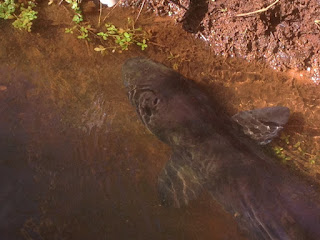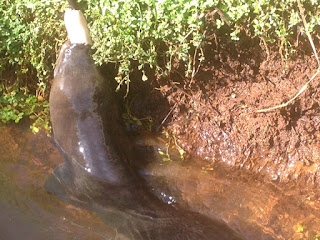
We have Longfin Eel in our Mangaiti Stream. This photo is of one up the headwaters at the Gordonton Road end that the local children regularly feed.

Longfin Eels are in the "at risk - declining" threatened status. They are the larger of our two eels. The other being the smaller and more common Shortfin Eel. The Longfin has a very interesting life cycle. They are endemic to New Zealand and grow in our rivers, streams and fresh water lakes to a good old age (can be 80 years). They are probably the biggest eel in the world. Slow growing and sometimes some females can reach 2 metres long and weigh up to 40kg.
On reaching their breeding size, the eels migrate to the sea. The details of the lifecycle are not clear. They swim for up to five or six months to tropical Pacific waters, possibly near Tonga, where they spawn and die. The eggs hatch into leaf-shaped larvae that float back to New Zealand on ocean currents.
Arriving in astounding numbers in spring, the larvae transform into slender, transparent “glass” eels. The glass eels soon turn into grey-brown elvers (young eels) and begin migrating upstream. And so the cycle repeats.
